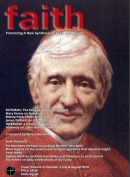Book Reviews
FAITH Magazine November-December 2007
Jesus of Nazareth
by Pope Benedict XVI, Bloomsbury, 374pp, £14.99
Christ the Lord, Out of Egypt
by Anne Rice, Random House, 350pp, £6.49
It may seem incongruous to review a book by a reigning Pope alongside a novel by a writer famed for her Vampire Chronicles, but both bring us face to face with the mystery of the Incarnation.
Benedict XVI has found time while being Pope to write about the current state of Christology – its highs and lows. “It is obvious that the way I look at the figure of Jesus goes beyond what much contemporary exegesis... has to say.”
The problem with much contemporary exegesis stems from its often unrecognised prejudice. Already in the mind is the preconception that there is a radical difference between the Jesus of history and the Christ of faith. Pope Benedict seeks to establish from the Scriptures themselves that the true, historical Jesus is the Christ in whom we believe. He is not merely the “new Jacob” but also the “new Moses”. As God spoke with Moses face to face, so Jesus, the prophet foretold in Deut 18:18, is with his Father on the Mountain in prayer; and teaching from the mountain is the “new Torah”. As St Leo says, “From the very nature of the place and of his deeds, he showed that he was the one that once had deigned to speak to Moses.” He does not merely proclaim the Kingdom, but “by the way in which hespeaks of the Kingdom of God, Jesus leads us to realise the overwhelming fact that in him God himself is present – that he is God’s presence.”
Many exegetes get enmeshed in the minutiae of the text and fail to realise that the evangelist in particular always “remembers in and with the Church.” Pope Benedict tells us that Jesus’ “entire preaching is a message about the mystery of his person, precisely because Jesus himself is God – the Son.”
Pope Benedict pays particular tribute to Rabbi Jacob Neusner, A Rabbi talks with Jesus, and Bishop John Robinson, A New Quest for the Historical Jesus. So also does Anne Rice. The author of The Vampire Lestatand other novels, she came back to the practice of her faith in 1998. As a result she decided to write about Jesus, conscious of the fact that “sceptical schools seemed so very sure of themselves.”
The resulting book begins with Jesus aged seven, leaving Egypt (where he meets Philo) and returning via Jerusalem to Galilee. She borrows from the apocryphal Gospels, the child Jesus bringing clay doves to life and curing various sick and blind people. She also sends John the Baptist off to Qumran, and puts Jesus to work in Sepphoris, painting wall decorations.
The narrative is reverent and well written. It charts the dawning consciousness of a child, “kept hidden” by Mary and Joseph, who witnessed marvellous scenes at his birth and then had to escape Herod’s slaughter. It ends with Jesus acknowledging his Father. Anne Rice has in fact reinforced the faith, as a novelist, in the same way that Pope Benedict has done, as a theologian.
James Tolhurst
Chislehurst Kent
Newman’s Approach to Knowledge
by Laurence Richardson, Gracewing, xii + 200pp, £9.99
It is somewhat frustrating to locate the genret o which this short treatise naturally belongs. Turgidity of language and argument belies its usefulness for the general reader, while its essentially descriptive character prevents the manifestation of anything profoundly new in relation to the ever-increasing corpuso f Newman studies that would require it to be essential reading for the scholar or expert. As a textbook for students in universities or seminaries, it has some grace in that it provides an introduction to the philosophy undergirding Newman’s faith processes, vitiated somewhat by lack of reference to the work of Grave on conscience, Verbeke on the Aristotelian roots of the illative sense, Harrold’s now somewhat mature critical study of Newman’s mind, thoughtand art, the views of Newsome and Robbins on the nature of The Grammarand the robustly critical approach of FitzPatrick. These writings do not feature in the bibliography.
In Richardson’s book there are seven chapters ranging from an examination of Newman’s early philosophical stance, the influences that formed him and led him to coherence in the development of his approach to knowledge and commitment, to his teaching on apprehension, assent, inference and the illative sense. The study concludes with an analysis of the insights Newman brings to bear upon contemporary philosophical understandings and his status as a latent forerunner of the phenomenological movement. The latter constitutes the essence of Richardson’s concluding chapter.
Newman’s concern with religious certitude can be traced to his early reading of Butler and to the interaction of Oriel relationships. Along with commonly-held views, Richardson regards The Essay in Aid of a Grammar of Assenta s Newman’s greatest work, more than a theological text, a work resting upon a firm philosophical and psychological basis which answers the problem of how truth is arrived at without exclusively pursuing a logical process. Richardson uses quotation from Newman liberally, eschewing Gerard Manley Hopkin’s criticism of Newman’s ‘narrow circle of instance and quotation’ which had dissatisfied him on first reading The Grammar. To him, it was ‘heavy reading’. Richardson is very skillful, however, in the use of selectionand evocative quotation, ensuring Newman is allowed to speak for himself in clarifying the process by which the human mind makes it possible to subscribe to an act of religious faith which is seen to be an act of the intellect. Man, thus, is not simply a reasoning being but ‘a seeing, feeling, contemplating, acting’ being.
The concept of the illative sense designates what William Robbins called ‘the reasoning from cumulative probabilities by which the mind is led to positive and fruitful belief’.In such a process, conscience plays a significant role. Alison Gray, in a recent doctoral study on the empirical use of material relating to The Essay in Aid of a Grammar of Assent, in relation to the teaching of Key Stage Three religious education in a Catholic school in England, has shown the inherent capacity of children to reach belief by a proper use and understanding of the illative sense.
There are three issues Richardson would have done well to address thoroughly. The first relates to the point aired by the late David Newsome when he wrote that ‘Newman waged a lifelong war against private judgement in matters of doctrine and revelation’and pointed out that ‘the error of Protestantism was to suppose that “religion was based not on argument but on taste and sentiment, that nothing was objective, everything subjective in doctrine”.’I t would have been significant if Fr Richardson had addressed this point vis-à-vis the illative sense. The key, of course, to its resolution lies in the use of conscience as safeguard from self-will. The second issue that could have beenaddressed is that raised by Patrick FitzPatrick who saw the ‘deprecation of reason in order to make faith more acceptable’a s a difficulty in Newman’s approach to his teaching of the illative sense. Finally, Newman was himself aware there is no formal proof of the reliability of the illative sense, a fundamental flaw necessitating discussion.
Professor V Alan McClelland
Leconfield East Yorkshire
Frederick William Faber: A Great Servant of God
by Melissa Wilkinson, Gracewing,322pp, £20
Most readers probably know Fr Faber as the author of Faith of our Fathers. Others will associate him with Cardinal Newman – probably seeing him in some sense as ‘Newman’s rival’. Indeed, Frederick Faber (somewhat like Cardinal Manning) has frequently been studied only in terms of his relationship with Newman – usually to his own disadvantage. Melissa Wilkinson’s new book seeks to place Faber centre stage, portraying him as a key player in the Nineteenth Century Church, and a figure comparable to – or in some respects even more significant than – Newman himself.
Undoubtedly, the subject does deserve a serious modern biography. Dr Wilkinson demonstrates that Faber reflected in his own person many of the great controversies of the Church in the Victorian era. Beginning life as a convinced young Evangelical, he gradually adopted the Tractarian High Churchmanship promoted by Keble and Newman, before embracing, with all possible fervour, the Ultramontane, Italianate Catholicism introduced into England by Cardinal Wiseman. When he died, an obituary in the secular Morning Postcould claim: ‘Of all the converts to Roman Catholicism from the Anglican Faith, none have been more zealous, more successful, more earnest than Father Faber’. Ye t today Faber’s reputation languishes in comparison to that of Newman. Why should this be?
Wilkinson’s book suggests some of the answer. Firstly, as she concludes: ‘Faber was essentially an apologist for his own individual reading of Catholicism’. This reading, as we have noted, was Italianate, Ultramontane, highly emotional and frequently expressed in passages of purple prose, which, as Wilkinson opines, occasionally topple over into ‘silliness’. Such a model of Catholicism was well-suited to High Victorian sensibilities, and made Faber a popular figure. Today, however, the style seems dated, whereas Newman’s more reserved approach has retained its appeal. Secondly, there is Faber’s own character to consider. Apologists for Newman have sometimes portrayed Faber as a hypochondriac neurotic, scheming to undermine Newman’s proper authority while frequently at odds with his owncommunity. Here, Wilkinson emphasises Faber’s genuine ill-health, which plagued him almost his entire life. She suggests, convincingly, that much of this was due to mercury poisoning, a side-effect of the terrifying array of Victorian drugs and potions Faber was prescribed by his doctors. This must account for much that was erratic or unsatisfactory in his dealings with others. Moreover, as even Newman’s fervent admirers would surely admit, the great Cardinal was hardly the easiest man to deal with, and quite as highly-strung as Faber. A merit of Wilkinson’s book is that it allows the Faber-Newman relationship to be viewed more impartially than is often the case.
The book makes one particular claim which deserves our attention. It was Faber, more than Newman, Wilkinson suggests, who was responsible for introducing the Oratorian model of spiritual life into the English Church. Faber had cherished a devotion to St Philip Neri, the original Oratorian, ever since his ordination as an Anglican on St Philip’s feast day. Moreover, Wilkinson has studied for the first time Faber’s rule for the ‘Brothers of the Will of God’ (or ‘Wilfridians’), the Catholic community he founded shortly after his conversion, and which predated Newman’s foundation of the Oratory. St Philip Neri was a major influence on this community, for instance in their insistence on ‘playful ways and sweet manners’, echoing St Philip’s command to be ‘cheerful and charitable’. Later, whensubmitting to the Oratorian rule proper, Faber revealed to Newman that St Philip’s picture was ‘on every door’ of the Wilfridian house. Certainly the book makes a convincing case that Faber possessed an earlier, and perhaps deeper, appreciation of Philippine spirituality than Newman, albeit that Newman (as Cardinal Wiseman recognised) was more capable of providing a sure foundation for the Oratorian life in the English context.
Wilkinson’s work, therefore, can be commended for its scholarship, and is an important contribution to our knowledge of the English Church in this period. It is a shame that it still reads very obviously like the doctoral thesis as which it began its life. The research is good, the conclusions solid, but the prose is often dense and the narrative flow poor, while every chapter is burdened with several hundred endnotes, far beyond the needs of the average reader. There still remains room for a genuinely popular biography of this great English Catholic.
Fr Richard Whinder
New Malden Surrey
Catholic Social Justice:
Theological and Practical Explorations
edited by Philomena Cullen, Bernard Hoose, and Gerard Mannion, Continuum, 250 pp, £18.99
Nothing illustrates more clearly the crisis in the Catholic Church in England than this book which attacks the present Pope, his predecessors, Christian marriage, and suggests that the blowing up of the twin towers in America might not be termed “terrorist”.
Let us be clear about the status of this book. It is published by a reputable publisher, Continuum, but it is a collection of articles by Caritas-Social action, an official agency of the Catholic Bishops’ Conference for England and Wales. It carries a supportive and laudatory Foreword by his lordship Bishop Budd, who starts by giving an account of the history of Caritas-social action. He takes responsibility for the book: “This faith-reflection activity that we called ‘social spirituality’ has given birth to the present volume.” The Introduction of the book is actually called “Caritas in Theory and Practice”. It is still advertised as I write this in late September on the Website of the Bishops’ Conference.
Among the authors are three who have kept the Congregation for the Doctrine of the Faith (CDF) busy. The editors offer an article of Hans Kung which is ten years old: “Ethics, Business and Managers”. It is as tendentious as it is boring and predictable. The CDF has declared of Fr Kung that he had “departed from the integral truth of the Catholic Faith.”
Then there is Fr Tissa Balasuriya whose article is called “Benedict XVI’s Deus Caritas Estand Social Action”. At one time he was actually excommunicated but had that lifted when he recited The Credo of the People of God. But he does not seem cowed. His judgement on the second half of Deus Caritas Est is succinct: “The claims in the encyclical in favour of the Church’s social action are hardly credible...”. But the present pope is not being singled out for censure. Fr Balasuriya also criticises Leo XIII’s Rerum Novarumand John Paul II’s Centesimus Annus. “One of their deficiencies is the lack of structural analysis in terms of global social justice. They were all written mainly from a European-dominated world view.” John Paul II isfurther taken to task for writing “disparagingly concerning Buddhism as negative.” In my judgement he hits a new low by stating: “The twenty-first century was born in violence, with the ‘terrorist’ air attack on New York on 11 September 2001...” In English one uses inverted commas when quoting someone or when conveying the sense of ‘so-called’. The effect is to question whether that act of murder can be regarded as terrorism.
Peter C. Phan is currently being investigated by the CDF. His article Christian Social Spiritualitypromotes Liberation Theology and he cites approvingly Jon Sobrino, just as Gerard Mannion quotes approvingly whom he calls “the esteemed moral theologian, Charles E. Curran.” Mannion also, in a method that is typical of the whole book simply asserts, “The Church gradually moved away from its opposition to socialism...” He quotes not one iota of evidence to back up this highly questionable statement.
Ms Philomena Cullen, one of the editors of the book, in her contribution, “Social Justice and the Open Family”, a feminist invective, attacks Catholic marriage. She condemns the ideology of what she calls “the nuclear family” (that is a wife and husband who have received the sacrament of matrimony and have children) claiming that it is, in some way, “a defence of capitalism”. She says that all dominant ideologies involve the misuse of power: “whether manifested as sexism, racism, disabilism, ageism, hetrosexism.” She argues for what she calls, “a feminist perspective in family theology”. In context this seems to this writer like arguing for “a vulpine perspective in the keeping of chickens”. Ms Cullen also criticises Deus Caritas Est.
Not all the other articles are as bad as these, but none redeems the book.
As is not infrequently the case with such patronisation of the Magisterium we are all financing this manifesto, as we are Caritas-social Action itself, via the Bishop’s Conference. This book is very far from being an explanation of Catholic Social Justice. It does not carry an Imprimatur.
Eric Hester
Bolton
Chaucer’s Triumph: Including the case of Cecilia Chaumpaigne, the seduction of Katherine Swynford, the murder of her husband, the interment of John of Gaunt and other offices of the flesh in the year 1399
by Garry O’Connor, Petrak Press, 294 pp, £15.99
To go from reading Chaucer to reading Chaucer’s Triumph is a sickening descent. It is characteristic of our age – but not Chaucer’s contemporaries – to think of him almost entirely in terms of The Canterbury Talesand the Wife of Bath’s tale in particular.
O’Connor chose an interesting year in which to set his story – 1399 – because John of Gaunt, Duke of Leicester (1340-1399), the third surviving son of King Edward III, was Chaucer’s patron. The story amounts to a kind of ‘London Pilgrimage’ as the Duke’s body is taken from Leicester Castle to its resting place in St Paul’s Cathedral. It is told in a series of flashbacks by various characters on the ‘Pilgrimage’, including John of Gaunt himself, Katherine Swynford (his third wife), Geoffrey Chaucer, and Adam Scrivener, Chaucer’s scrivener or copyist. There is a Who’s Who at the beginning of the book which anyone not an historian will certainly need. Much thought went into weaving the various strands of John of Gaunt’s life together with that of Chaucer, and thebook contains a valuable Endnote on the author’s sources.
What of the story itself? At the mention of Troilus and Criesydeearly in the book my heart leapt – hoping beyond hope we would have Chaucer’s reflections on what I think his greatest work. As O’Connor makes much of Chaucer’s Retraction, surely this would have been the place to quote the lines addressed to those ‘yonge fresshe folkes, he or she’ whom Chaucer urges to ‘Repeyreth hoom from worldly vanitee.’ It was not to be. In fairness to the author, he probably felt he ought to confine most of his comments to The Canterbury Tales because Chaucer was possibly still working on it at this time. Again my heart gave a leap. Would the biographer of Pope John Paul II entertain us with conversation between Chaucer and the Scrivener about The Knight’s or The Parson’sTales?
It was not to be. Our noses are held relentlessly and continuously to the grindstone of what is mainly the imagined bawdiness of Chaucer both in his life and his poetry. If the reader expects to be entertained, instead, by the story of the delightful Wife of Bath and her tale about ‘What women most desire in the world’ – even that is denied us.
I’ve never read a novel in which I felt so many excellent opportunities were lost. It is bad enough that it is told in an extremely circuitous manner. Whatever you make of the lewdness of some of the Canterbury pilgrims, those pilgrims – blissfully unaware of their imbedded Catholicism and goodness – were far more interesting that the gratuitous reflections by Lady Katherine and nearly everyone else – including Chaucer – on fornication. This is a book I can imagine DH Lawrence writing if he were a Catholic. O’Connor puts great emphasis on Chaucer’s so-called ‘raptus’o f Cecilia Chaumpaigne when it is remains unclear whether raptusmeant rape or possibly kidnapping. In any event, the issue was not resolved and it left no stain on Chaucer’s character. Inever had an opinion on the matter, but the ‘confession’ O’Connor puts into Chaucer’s mouth convinces me that that there never was a rape, and that the author’s straining after one is the main reason why what might have been a good novel is ruined by salaciousness for its own sake.
When the procession stops for the night at St Alban’s Abbey and we meet Brother Thomas Walsingham, the Abbot, I thought we might finally learn something about medieval Catholicism. The Abbot’s talk reminded me of the tersely-expressed but profound theological ideas we find in Chaucer. But the author ruins it by having the Scrivener being seduced by a young woman in the Abbey. This is followed by the final stage of Chaucer’s confession to the Scrivener of his ‘rape’ of Cecilia Chaumpaigne, which continues right up to the entombment of John of Gaunt. I will not, like the Wife of Bath, say of the author – ‘God sende hem soone verray pestilence.’ But if the presenter of Desert Island Discs allowed me to take 500 books to a desert island this would not be one of them.
Walter Hooper
Oxford






